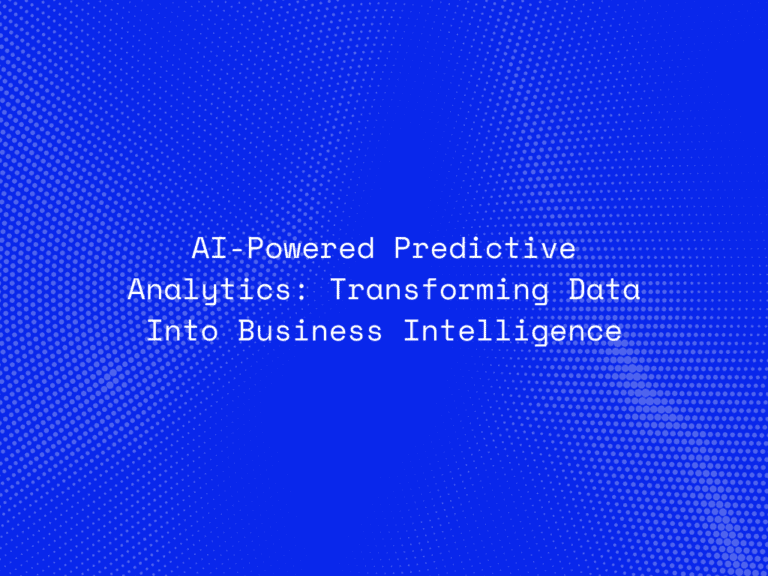Machine learning (ML) is at the core of modern data science, enabling businesses to extract insights, automate processes, and make data-driven decisions. However, successful ML deployment goes beyond just building a predictive model—it requires seamless integration of ML outputs into business workflows, applications, and decision-making systems.
This guide explores the key steps in ML modeling and how to effectively integrate ML outputs into production environments. Whether you’re a beginner or an experienced data scientist, mastering these concepts will help you build scalable and impactful ML solutions.
Step 1: Building a Machine Learning Model
Developing an ML model involves several crucial steps:
1.1 Problem Definition and Data Collection
Before training a model, it’s essential to define the problem and identify the right dataset. Common ML tasks include:
- Classification: Predicting categories (e.g., spam detection, sentiment analysis)
- Regression: Predicting continuous values (e.g., sales forecasting)
- Clustering: Grouping similar data points (e.g., customer segmentation)
- Anomaly Detection: Identifying outliers (e.g., fraud detection)
Key considerations:
- Gather high-quality, labeled datasets.
- Clean and preprocess data to handle missing values, duplicates, and inconsistencies.
- Perform exploratory data analysis (EDA) to understand data distribution and patterns.
1.2 Feature Engineering
Feature engineering involves creating relevant input variables to improve model performance. This includes:
- Feature selection: Choosing the most important variables.
- Feature extraction: Transforming raw data into meaningful inputs (e.g., word embeddings for NLP).
- Feature scaling: Normalizing numerical values to ensure stability in training.
1.3 Model Selection and Training
Choosing the right algorithm depends on the problem type and dataset characteristics. Popular ML models include:
- Linear models: Logistic regression, linear regression
- Tree-based models: Decision trees, Random Forest, Gradient Boosting (XGBoost, LightGBM)
- Neural networks: Deep learning models for complex tasks
- Unsupervised learning models: K-means, DBSCAN, PCA
Train the model using appropriate hyperparameters and validate it using cross-validation to avoid overfitting.
1.4 Model Evaluation
Use performance metrics to assess model effectiveness:
- Accuracy, Precision, Recall, and F1-score for classification
- Mean Squared Error (MSE) and R² Score for regression
- Silhouette Score and Inertia for clustering
If the model underperforms, consider hyperparameter tuning, feature engineering, or using a more complex architecture.

Step 2: Deploying the ML Model
Once an ML model is trained and validated, the next step is deployment. The goal is to make predictions available to end-users or business applications.
2.1 Model Serialization and Export
Before deployment, the trained model needs to be saved. Common formats include:
- Pickle (.pkl): For Python-based models
- ONNX: For cross-platform compatibility
- TensorFlow SavedModel: For deep learning models
2.2 Deployment Options
ML models can be deployed using:
- Batch Processing: Predictions are generated periodically (e.g., daily fraud detection reports).
- Real-time APIs: RESTful APIs or GraphQL endpoints serve predictions on demand.
- Edge Deployment: Model runs on local devices (e.g., mobile AI applications).
- Cloud Deployment: Models are hosted on platforms like AWS SageMaker, Google AI Platform, or Azure ML.
2.3 Model Monitoring and Maintenance
Continuous monitoring is crucial to detect performance degradation. Best practices include:
- Logging predictions and monitoring data drift (shifts in input data).
- Setting up automated retraining pipelines to keep models up to date.
- Using MLOps to manage the entire ML lifecycle efficiently.
Step 3: Integrating ML Outputs into Business Workflows
3.1 Understanding ML Outputs
ML models generate different types of outputs depending on their use case:
- Classifications (Yes/No, Spam/Not Spam)
- Numerical Predictions (Sales Forecasting, Price Estimations)
- Rankings (Recommendation Systems, Search Engine Results)
- Clustering Results (Customer Segmentation, Fraud Detection Groups)
3.2 Business Integration Strategies
To ensure ML insights are actionable, integrate outputs into operational workflows:
1. Automated Decision-Making
- Fraud detection systems automatically flag suspicious transactions.
- AI-powered chatbots provide instant customer responses based on sentiment analysis.
2. Dashboard Integration
- Predictions are visualized in BI tools like Tableau or Power BI.
- KPI dashboards update dynamically based on real-time ML outputs.
3. Trigger-Based Actions
- Marketing automation: AI-driven customer segmentation triggers personalized email campaigns.
- Healthcare applications: Anomaly detection models alert doctors about potential health risks.
3.3 Handling Uncertainty in ML Predictions
Since ML models are probabilistic, businesses must handle uncertainty by:
- Implementing confidence thresholds (e.g., requiring a 90% certainty for fraud alerts).
- Allowing human intervention when predictions are ambiguous (e.g., AI-assisted medical diagnosis).
Step 4: Scaling and Improving ML Models
4.1 Continuous Learning and Model Retraining
ML models degrade over time due to data drift. Implement:
- Scheduled retraining using updated datasets.
- Online learning for real-time model adaptation.
4.2 A/B Testing for Model Performance
Deploy multiple models and compare their performance before full-scale integration.
4.3 Feedback Loops
Use real-world data and user interactions to refine models dynamically.
Conclusion
Building an ML model is just the beginning—seamless output integration into business applications ensures that ML insights drive real-world impact. From selecting the right model to deploying and scaling it, a well-structured ML pipeline is crucial for success.
By following best practices in model deployment, real-time integration, and continuous improvement, data scientists can develop robust, production-ready AI systems that enhance decision-making and automation across industries.




